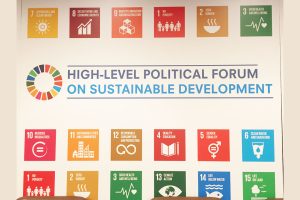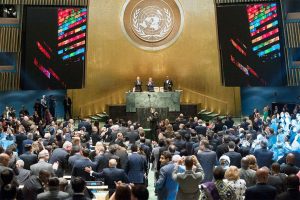15 July 2019: As part of the 2019 session of the UN High-level Political Forum on Sustainable Development (HLPF), countries, UN officials and stakeholders shared views on the four first years of Voluntary National Reviews (VNRs), during which 142 countries presented reports. The discussion highlighted the VNRs’ areas of added value, challenges and lessons learned, as well as specific initiatives taken at the regional and national levels to make progress on the 2030 Agenda.
The discussion is expected to contribute to the SDG Summit in September 2019, as well as the intergovernmental review of the HLPF during the UN General Assembly’s (UNGA) 74th session.
Moderating the session, Achim Steiner, UN Development Programme (UNDP) Administrator, noted that whether the VNRs achieve their intended impact or not, they will continue to be judged critically. He also noted the need to recognize that not everybody has to be an “SDG expert” in order to contribute to the Goals.
SDG 10 requires the most attention, as it is mentioned by almost all VNRs but they lack strategies to achieve it.
Luis Gerardo Gonzalez Morales, Statistics Division, UN Department of Economic and Social Affairs (DESA), announced that DESA, in collaboration with UNDP and other partners, is developing a new online platform that includes visualization functions to help policymakers analyze VNR reports. Among other functions, the platform will enable comparisons between reports from the same country over time. Morales also referred to the Open SDG Data Hub that features SDG data by country.
On the VNRs’ added value, Armida Salsiah Alisjahbana, UN Economic and Social Commission for Asia and the Pacific (ESCAP) Executive Secretary, said the VNR process helped to institutionalize SDG coordination mechanisms in countries. She said it also helped to clarify responsibilities, and inspired innovation, initiatives and public debate. The EU said VNRs played a “major role” in the success of the HLPF during its first cycle, and their quality has improved over the years. Norway characterized the VNRs as a tool for peer learning, and as “instrumental” for ensuring dialogue between each government and “its peoples.” Sri Lanka said the VNR process helped identify challenges, and is important for identifying gaps and the way forward on the SDGs at the country level.
Ireland remarked that its 2018 VNR helped establish a baseline for future reporting.
On challenges, Mexico outlined issues related to: implementing the 2030 Agenda in a cross-cutting way; statistics; and leaving no one behind. Tunisia highlighted difficulties in “disseminating a culture of SDGs” at the local level, and involving parliamentarians in SDG implementation. Regarding the regional level, Alisjahbana highlighted challenges on: achieving coherence, integration and coordination; ensuring multi-stakeholder participation and engagement in VNRs and SDG implementation; data availability, reliability and having access to disaggregated data; and aligning various reporting requirements.
Based on the results on an independent review of the 2018 VNR reports by a coalition of stakeholders, Shannon Kindornay, Canadian Council for International Co-operation (CCIC), said: there is little evidence of institutionalized, multi-stakeholder engagement for SDG implementation in governments; there is little support from governments for non-state actors to engage in the VNRs; and there is a lack of attention to the principles of the 2030 Agenda, such as intergenerational equity in the reports.
One participant noted that many VNR teams rely on consultants to prepare their report, which defies the need to create ownership. They also said that only a few countries really follow-up on their VNRs after their presentations at the HLPF, and there is a need to strengthen the SDG capacity of parliamentarians, especially in developing countries.
On lessons learned, Sakiko Fukuda-Parr, The New School, and Member of the UN Committee for Development Policy (CDP), reported on an analysis of the 2018 VNRs, saying: SDG 10 (reduced inequalities) is the Goal that requires the most attention, since it is mentioned by almost all the VNRs but strategies to achieve it are vague or inexistent in the reports; giving priority to the furthest behind is not addressed by a majority of VNRs; and more attention is needed to address the root causes of inequalities, considering that inequalities are on the rise.
Kindornay shared findings of policy briefs prepared by CCIC in collaboration with other stakeholders to validate good practices in the VNRs, noting that including the 2030 Agenda in national legislation is key for progress. She said that while good building blocks exist in countries for advancing the Agenda, challenges lie in implementation. Chris Derksen-Hiebert, World Vision, echoed this comment, noting that progress towards the 2030 Agenda has not been realized in many countries. He highlighted the “crucial role” of civil society for achieving the Goals.
Judy Njino, Global Compact Network Kenya and Chair of UN Global Compact Africa Region Network Council, called for moving from awareness creation to action, and for companies to deliver impact. Ireland said stakeholders involved in the drafting of civil society reports should be involved in the VNR.
The EU said the second cycle of the HLPF should become more “comprehensive” and supported by statistical data. He also called for robust monitoring data and indicators.
Some officials highlighted initiatives carried out at regional and national levels to make progress on the SDGs. Ireland reported on the establishment of a Youth Council for the SDGs, and of 12 National SDG Champions. Abel Hibert, Office of the President for Analysis and Innovation, Mexico, said the government is working with Congress and the Chamber of Deputies and Senators to make society aware that the Goals and targets of the 2030 Agenda are inter-related.
Rita Schwarzelühr-Sutter, Parliamentary State Secretary, Federal Ministry for Environment, Nature Conservation and Nuclear Safety (BMU), Germany, said the German Parliament discusses the SDGs during specific sessions, and parliamentarians are part of the German delegation at the HLPF. She further noted that the German Council for Sustainable Development reports to the government every year, there will be a 2020 update of the German National Sustainable Development Strategy, and a climate cabinet under the leadership of the Chancellery is preparing legislation to ensure that the country meets its climate targets. She also mentioned that the German government hosts a transnational peer learning network on VNRs.
Vietnam said it presented its VNR in 2018, it formulated national indicators and a roadmap for implementing the SDGs, and the Goals have been integrated in several plans and policies. Alisjahbana said ESCAP developed a methodology to assess inter-linkages between the SDGs, and provides capacity building support for statistical offices.
The HLPF takes place from 9-18 July 2019 in New York, and 47 countries are presenting their VNRs from 15 to 18 July. In addition, 30 countries have announced their intention to carry out a VNR in 2020. [HLPF 2019 Website] [Background Note for Discussion] [SDG Knowledge Hub Sources]


